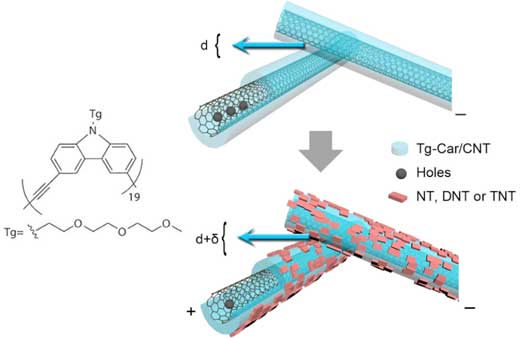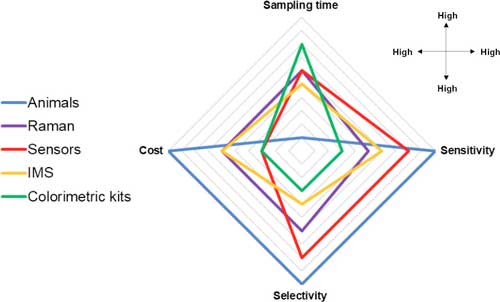| Aug 26, 2020 | |
Nanotechnology for explosives trace detection |
|
| (Nanowerk Spotlight) Whether it's an airport screening station or in-the-field terrorism investigations, trace detection of explosives – which are chemical compounds – generally involves the collection of vapor or particulate samples from these chemicals and analyzing them using a sensitive sensor system. | |
| Explosive trace detection (ETD) is a challenging task. As the name suggests, 'trace' refers to quantities of materials difficult to see with the naked eye. In ETD, this quantity can be considered to be < 1mg. | |
| Various factors, such as wide variety of compounds that can be used as explosives, the vast number of deployment means, and the lack of inexpensive sensors providing both high sensitivity and selectivity, have made trace detection a complex and costly task. | |
| The majority of particulate sampling is achieved through use of sampling wands. Sampling also requires intuition from the security agent to select areas most likely to contain an explosive trace. Vapor sampling is even more challenging as many explosives have very low vapor pressures. Sampling liquids raises practical issues, and through-barrier screening is limited to a small number of technologies. Many explosives are also considered “sticky” and will adhere to a range of surfaces. For materials with high surface energies, this could result in accumulation of explosive particles, thus limiting the number of analyte molecules per volume of sample. | |
| To complicate things even more, the operational environment also presents challenges. Passenger screening requires technologies with fast analysis times, low false alarm rates, and minimal disruption. Cargo is usually wrapped in protective materials, which may restrict efficient sampling. Screening baggage poses logistical issues. In all cases, there will be interference from benign materials, which could cause false positive alarms, so technologies need to be selective. | |
| A new review published in ACS Nano ("Recent Developments in the Field of Explosive Trace Detection") reports on the latest developments in key ETD technologies. For each technology, the authors describe general principles as well as advances in these areas along with examples of in-field devices. They also discuss developing technologies and include sensor platforms used in artificial olfaction systems and nanomaterials technology. | |
| Amazingly enough, animals still remain a benchmark for emerging technologies with key attributes being high selectivity, sensitivity, concurrent detection of multiple analytes, and fast screening times. | |
| The detection capabilities of animals far exceed many of the current technologies in use today, and as such, there is a continuing need for animals in explosives’ detection. One of the key advantages of biological systems is concurrent detection of multiple analytes of interest in real-time, which is a challenging task and difficult to achieve even with integrated sensing technologies. Examples of animal systems used in explosives’ detection include dogs, rats, honey bees, and pigs. | |
 |
|
| Sensing of nitroaromatic explosives using carbon nanotubes. (A) Sensor using single-walled carbon nanotubes (CNTs) modified with Tg-Car oligomer (structure inset). The schematic shows charge carriers moving in the Tg-Car/CNTs before and after exposure to nitroaromatic explosives (NT, DNT, and TNT). (Reprinted with permission by American Chemical Society) | |
| An extensive part of the review deals with the use of nanotechnology materials in ETD sensor technologies. Nanostructured materials provide high surface areas for detection, and selectivity can be achieved by utilizing their unique electrical, optical, catalytic, magnetic, and mechanical properties. The authors describe ETD platforms that use inorganic as well as organic semiconductor nanoparticles, carbon nanotubes, graphene, metal-organic frameworks (MOFs) and quantum dots. | |
| Apart from nanomaterials and MEMS-based sensors, technologies that are described and discussed in detail with the latest developments are ion mobility spectrometry (IMS), colorimetric kits, and raman spectroscopy. | |
 |
|
| Visual comparison of ETD technologies based on sampling time, sensitivity, molecular selectivity and cost. (Reprinted with permission by American Chemical Society) (click on image to enlarge) | |
| The majority of in-field systems have sampling times within minutes, and this has also been observed in many emerging technologies reviewed by the authors. IMS remains a key technology in the field of ETD due to having good overall sensitivity, selectivity, and analysis times in seconds. | |
| However, current IMS systems lack molecular selectivity compared with spectroscopic approaches such as Raman and absorption/emission spectroscopy, which can provide molecular fingerprinting and functional group information. Ions generated from benign materials with similar mobilities to explosive ions can trigger false positive responses, and such interferences include oils, creams, perfumes, and medication. | |
| Concluding their review, the authors point out that it is likely that nanomaterials will play an important role in the development of future ETD technologies: "We have seen significant developments made in gas sensing such as graphene and quantum dots, with some systems able to detect multiple classes of explosives at low concentrations. SERS also continues to be an active area, through developments improving the properties of plasmonic and nonplasmonic nanoparticles." | |
| They add that, whereas sensitivity and selectivity remain important goals for ETD systems, consideration of the operational environment is also important for design of future systems as deployment is a balancing act of many considerations. These include, cost, sampling throughput, sampling time, portability, and ease of operation. | |
| Computational chemistry has not been discussed in the review but is one approach which could be used to develop rationally designed sensing materials. Other computational approaches beneficial for ETD would be modeling explosive adsorption on surfaces and vapor plumes in confined areas to improve screening procedures and placement of sensors. | |
 By
Michael
Berger
– Michael is author of three books by the Royal Society of Chemistry:
Nano-Society: Pushing the Boundaries of Technology,
Nanotechnology: The Future is Tiny, and
Nanoengineering: The Skills and Tools Making Technology Invisible
Copyright ©
Nanowerk LLC
By
Michael
Berger
– Michael is author of three books by the Royal Society of Chemistry:
Nano-Society: Pushing the Boundaries of Technology,
Nanotechnology: The Future is Tiny, and
Nanoengineering: The Skills and Tools Making Technology Invisible
Copyright ©
Nanowerk LLC
|
|
|
Become a Spotlight guest author! Join our large and growing group of guest contributors. Have you just published a scientific paper or have other exciting developments to share with the nanotechnology community? Here is how to publish on nanowerk.com. |
|
